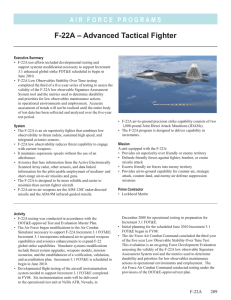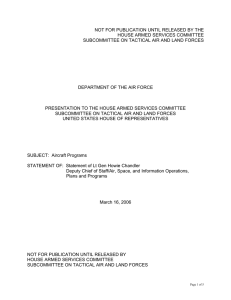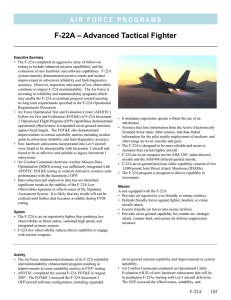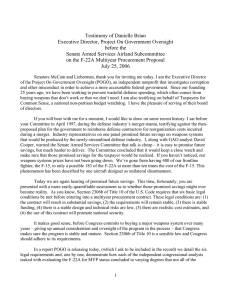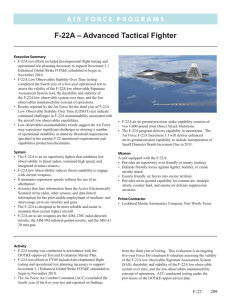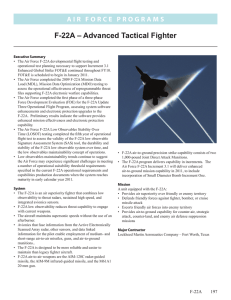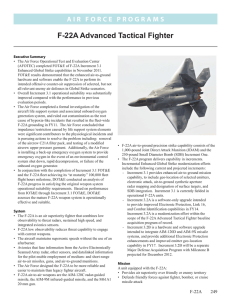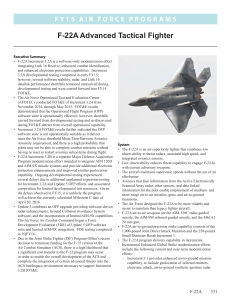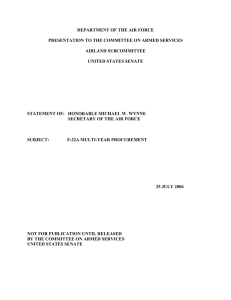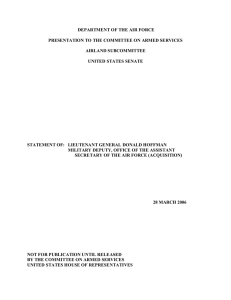F-22A Advanced Tactical Fighter
advertisement
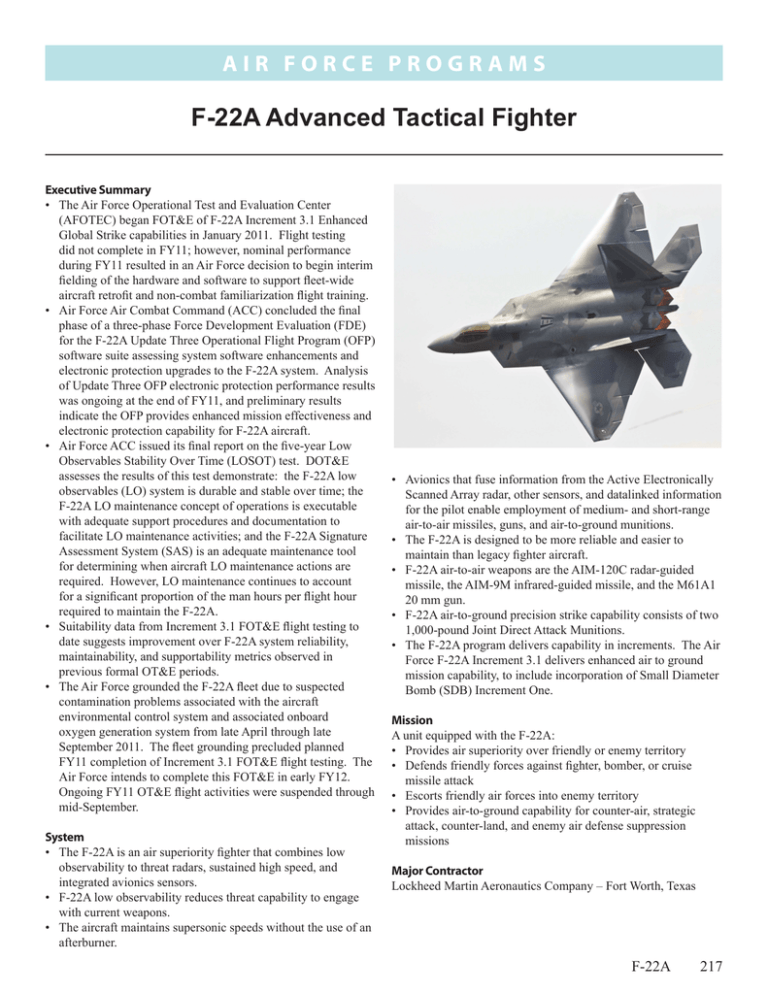
Ai r F o r c e P ROGRAMS F-22A Advanced Tactical Fighter Executive Summary • The Air Force Operational Test and Evaluation Center (AFOTEC) began FOT&E of F-22A Increment 3.1 Enhanced Global Strike capabilities in January 2011. Flight testing did not complete in FY11; however, nominal performance during FY11 resulted in an Air Force decision to begin interim fielding of the hardware and software to support fleet-wide aircraft retrofit and non-combat familiarization flight training. • Air Force Air Combat Command (ACC) concluded the final phase of a three-phase Force Development Evaluation (FDE) for the F-22A Update Three Operational Flight Program (OFP) software suite assessing system software enhancements and electronic protection upgrades to the F-22A system. Analysis of Update Three OFP electronic protection performance results was ongoing at the end of FY11, and preliminary results indicate the OFP provides enhanced mission effectiveness and electronic protection capability for F-22A aircraft. • Air Force ACC issued its final report on the five-year Low Observables Stability Over Time (LOSOT) test. DOT&E assesses the results of this test demonstrate: the F-22A low observables (LO) system is durable and stable over time; the F-22A LO maintenance concept of operations is executable with adequate support procedures and documentation to facilitate LO maintenance activities; and the F-22A Signature Assessment System (SAS) is an adequate maintenance tool for determining when aircraft LO maintenance actions are required. However, LO maintenance continues to account for a significant proportion of the man hours per flight hour required to maintain the F-22A. • Suitability data from Increment 3.1 FOT&E flight testing to date suggests improvement over F-22A system reliability, maintainability, and supportability metrics observed in previous formal OT&E periods. • The Air Force grounded the F-22A fleet due to suspected contamination problems associated with the aircraft environmental control system and associated onboard oxygen generation system from late April through late September 2011. The fleet grounding precluded planned FY11 completion of Increment 3.1 FOT&E flight testing. The Air Force intends to complete this FOT&E in early FY12. Ongoing FY11 OT&E flight activities were suspended through mid-September. System • The F-22A is an air superiority fighter that combines low observability to threat radars, sustained high speed, and integrated avionics sensors. • F-22A low observability reduces threat capability to engage with current weapons. • The aircraft maintains supersonic speeds without the use of an afterburner. • Avionics that fuse information from the Active Electronically Scanned Array radar, other sensors, and datalinked information for the pilot enable employment of medium- and short-range air-to-air missiles, guns, and air-to-ground munitions. • The F-22A is designed to be more reliable and easier to maintain than legacy fighter aircraft. • F-22A air-to-air weapons are the AIM-120C radar-guided missile, the AIM-9M infrared-guided missile, and the M61A1 20 mm gun. • F-22A air-to-ground precision strike capability consists of two 1,000-pound Joint Direct Attack Munitions. • The F-22A program delivers capability in increments. The Air Force F-22A Increment 3.1 delivers enhanced air to ground mission capability, to include incorporation of Small Diameter Bomb (SDB) Increment One. Mission A unit equipped with the F-22A: • Provides air superiority over friendly or enemy territory • Defends friendly forces against fighter, bomber, or cruise missile attack • Escorts friendly air forces into enemy territory • Provides air-to-ground capability for counter-air, strategic attack, counter-land, and enemy air defense suppression missions Major Contractor Lockheed Martin Aeronautics Company – Fort Worth, Texas F-22A 217 Ai r F o r c e P ROGRAMS Activity • The Air Force conducted F-22A testing in accordance with the DOT&E-approved Test and Evaluation Master Plan and FOT&E and FDE test plans. • The Air Force began F-22A Increment 3.1 Enhanced Global Strike FOT&E in January 2011. AFOTEC completed associated air-to-air and air-to-ground weapons testing and Advanced Combat Simulator mission testing in FY11. Open‑air Increment 3.1 FOT&E flight test missions on the Nevada Test and Training Range (NTTR) did not complete as planned in FY11 due the grounding of the F-22A fleet from April through September 2011. Increment 3.1 FOT&E is expected to complete flight test missions in early FY12. In July 2011, the Air Force authorized an early fielding of the capability prior to conclusion of remaining NTTR mission testing to support aircraft retrofit and non-combat flight training across the F-22A fleet based on preliminary results of FOT&E testing. • Air Force ACC concluded the final phase of a three-phase FDE for the F-22A Update Three OFP assessing system software enhancements and electronic protection upgrades to the F-22A system. Analysis of Update Three OFP electronic protection performance results was ongoing at the end of FY11. • Air Force ACC issued its final report on the five-year LOSOT test. This evaluation assessed the validity of the F 22A low observable SAS, durability and stability of the F-22A LO system over time, and the LO maintainability concept of operations. Assessment • Preliminary results of Increment 3.1 FOT&E testing in FY11 suggest that the enhanced air-to-ground capabilities will permit the F-22A to perform its intended offensive counter-air suppression of enemy air defenses mission in Global Strike scenarios. - FOT&E 3.1 weapons testing results demonstrated the F-22A remains capable of effectively employing legacy JDAM, AIM-9M, and AIM-120C weapons as well as the newly incorporated SDB. - Aircrews are capable of using the F-22A radar and onboard sensors to locate and designate surface targets with sufficient accuracy to effectively employ air-to ground weapons to suppress enemy air defenses. - Suitability data from 225 sorties and 445 flight test hours suggest improvement over previous F-22A reliability, maintainability, and supportability metrics observed in previous formal OT&E periods. - Preliminary trends suggest Increment 3.1 mission capable rates are comparable to those observed in previous OT&E periods. Similarly, testing trends suggest a significant increase in Mean Time Between Critical Failure (MTBCF) compared to previous OT&E periods. Increment 3.1 observed MTBCF in FY11 FOT&E testing to date was 4.01 hours (80 percent lower confidence bound) compared to the reported MTBCF in FY07 FOT&E of 1.73 hours, 218 F-22A suggesting Increment 3.1 configured F-22As should be better able to satisfy Air Force operational mission availability and sortie generation rate requirements than previous configurations. Final determination of progress in satisfying the F-22A “at maturity” operational suitability thresholds will be made in conjunction with the conclusion of Increment 3.1 FOT&E in early FY12. • At the completion of the five-year LOSOT FDE, DOT&E assesses the following: - The F-22A LO system is durable and stable over time. - The F-22A LO maintenance concept of operations is executable, and support procedures and documentation are adequate to support LO maintenance activities. - The F-22A SAS is an adequate tool for determining when aircraft LO maintenance actions are required. - LO maintenance accounts for a significant proportion of the man hours per flight hour required to maintain the F-22A affecting aircraft operational availability, mission capable rates, and sortie generation rates. The original LO maintenance manpower estimate was 1.67 spaces per aircraft. The Air Force has increased LO personnel authorizations to 3.1 spaces per aircraft at F-22A operational units to meet the increased manpower demands associated with maintaining the LO system. - The Air Force has begun implementation of measures aimed at assisting in the long term maintenance of the F-22A LO system. In FY10, the Air Force instituted F-22A Signature Management Program, a flight test program to verify the long-term signature stability of the operational F-22A fleet and to continue to verify and refine SAS. Since then the Air Force has acted to procure and field an LO Repair Verification Radar tool to aid in evaluating and verifying LO repairs and assist in performing periodic maintenance audits of the LO system. Additionally, the Air Force has made funds available for periodic aircraft LO reduction efforts wherein contract field teams restore the F-22 LO system to production signature levels. These measures, in conjunction with increased LO manpower should enable the Air Force to continue to maintain the F-22 LO system within tolerances necessary to meet operational mission requirements. Recommendations • Status of Previous Recommendations. The Air Force continues to address all previous recommendations. • FY11 Recommendations. The Air Force should: 1. Continue to fund and implement measures begun to assist in the long-term maintenance of the F-22A LO system to include: the Signature Management Program; the Repair Verification Radar tool; and periodic field team aircraft LO reduction for operational unit F-22As. 2. Complete the ongoing FOT&E to fully characterize F-22A Increment 3.1 effectiveness, suitability, and mission capability.
